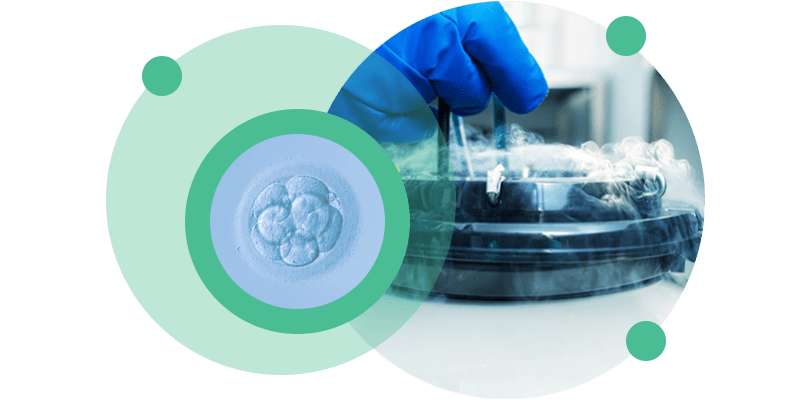Embryo Cryopreservation
Embryo cryopreservation is a procedure performed when there are good quality embryos that will not be transferred to the patient’s uterus in that treatment cycle.
Embryo cryopreservation is performed using the vitrification technique. In our laboratory, embryos that are 5th or 6th day of development, of good quality and that have not been transferred are cryopreserved.

About Embryo Cryopreservation
Embryo cryopreservation is performed using the vitrification technique – a rapid freezing method that uses cryoprotectant solutions to protect the embryo cells from rapid cooling. Embryos are cryopreserved in devices called straws. These straws are stored in liquid nitrogen containers (-196 o C).
During an In Vitro Fertilization (IVF or ICSI) cycle, several oocytes are fertilized in order to increase the probability of obtaining embryos with the potential to result in a pregnancy. For this reason, we can obtain more embryos than those that will be transferred in that cycle.
In other situations, it may not be safe or advantageous to transfer the embryos in the same cycle in which they were created, either due to the risk of Ovarian Hyperstimulation Syndrome or due to desynchronization of the endometrium with the phase of the cycle in which the embryos are to be transferred.
In these cases, the embryos can be cryopreserved for use in a later treatment cycle.
In Pre-implantation Genetic Diagnosis cycles, it is also necessary to resort to cryopreservation of the tested embryos until the results of the genetic tests are obtained.
Embryos can be cryopreserved in the cleavage phase (3rd day of development) or in the blastocyst phase (5th/6th day of development).
Cryopreservation in the cleavage phase is already uncommon since freezing blastocysts offers greater guarantees of success. The blastocyst is an embryo that has already demonstrated the capacity for differentiation into the different structures that compose it (Inner Cell Mass and Trophectoderm), allowing a more specific morphological classification than the cleavage phase.
Cryopreserved embryos are thawed hours before being transferred to the patient’s uterus, whose endometrium is already prepared, through medication or naturally, to receive the embryos.
After thawing, the embryos remain in culture until transfer, and their development is carefully monitored to ensure their survival and quality.
Embryo cryopreservation by vitrification is a very common technique in Medically Assisted Reproduction laboratories and has good embryonic survival and pregnancy rates.





Frequently Asked Questions
Several studies have concluded that embryo cryopreservation does not carry increased risks and that there is no proven correlation between complications in pregnancy or in the health of the mother or baby when cryopreserved embryos are used.
Although embryo vitrification is a well-established technique in Assisted Reproduction laboratories, it is not possible to guarantee that the embryo will survive the freezing and thawing procedures. However, the embryo survival rate is quite high, and situations in which an embryo does not survive the procedure are rare. It is important that these techniques are performed by experienced professionals.
At the beginning of an IVF/ICSI treatment, you will sign an Informed Consent Form specific to that treatment where you must express your agreement or not to cryopreserve any possible surplus embryos resulting from that treatment.
Once cryopreservation has occurred, you will have to sign a new Informed Consent specific to cryopreservation.
According to current Portuguese Law, embryos can remain cryopreserved for a period of 3 years, renewable for an additional period of 3 years.
If you do not wish to transfer the embryos that you have cryopreserved, you may consent to their donation to other beneficiaries of Medically Assisted Reproduction treatments or to their donation to scientific research projects. If you do not consent to any of these destinations, the embryos will be thawed and discarded.
Embryo cryopreservation is a technique that allows good quality embryos that would not be transferred in the treatment cycle in which they were created to not be discarded. However, the creation of surplus embryos is not the objective of an IVF/ICSI treatment, so it is not possible to guarantee that embryo cryopreservation will occur.
At CETI, embryo cryopreservation has no additional costs but is subject to the payment of a maintenance fee after the first year.
You can consult CETI’s price list here.
